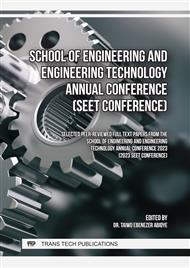[1]
M. Ahmaruzzaman, A review on the utilization of fly ash, Progress in energy and combustion science, 36 (2010) 327-363.
DOI: 10.1016/j.pecs.2009.11.003
Google Scholar
[2]
W.R. Bruce, C. Art, F. Ahmed, S. Konstantin, Fly Ash - An important ingredient for use in Hot-Mix ASHphalt concrete, International Conference on Sustainable Construction Materials and Technologies, 4 (2016)
DOI: 10.18552/2016/scmt4s246
Google Scholar
[3]
A.A. Radwan, M.K. Satar, N.A. Hassan, K.U. Rogo, The influence of coal fly ash on the mechanical properties of hot mix asphalt mixture. IOP Conf. Series: Earth and Environmental Science 971 (2022)
DOI: 10.1088/1755-1315/971/1/012012
Google Scholar
[4]
F.A. Aliaa, Effect of fly-ash on the performance of asphalt concrete mixes. Journal of Babylon University, Engineering Sciences, 25(5) (2017) 1693-1703.
Google Scholar
[5]
H. Akhtar, K. Tasaddik, A. Jonayed, Ashikuzzaman, Influence of fly ash as mineral filler in bituminous mix design, Trends in Civil Engineering and its Architecture, 3(1) (2018).
DOI: 10.32474/tceia.2018.03.000156
Google Scholar
[6]
N.D.S. Campelo, K.J. Costa, R.K. Vieira, A.K. Vieira, Use of Waste Foundry Sand (WFS) as filler in Hot-Mixed Asphalt concrete. IntechOpen (2019)
DOI: 10.5772/intechopen.89715
Google Scholar
[7]
Foundry Industry Recycling Starts Today, Foundry Sand Facts for Civil Engineers. Washington, DC: Federal Highway Administration Environmental Protection Agency, 2004.
Google Scholar
[8]
O. Yazoghli-marzouk, N. Vulcano-greullet, L. Cantegrit, L. Friteyre, A. Jullien, Recycling foundry sand in road construction – field assessment. Construction and Building Materials, 61 (2014) 69-78.
DOI: 10.1016/j.conbuildmat.2014.02.055
Google Scholar
[9]
B. Aktas, S. Aslan, Comparative evaluation of replacement foundry sand with mineral fine aggregates on HMA properties, The Online Journal of Science and Technology, 7(3) (2017) 19-23.
Google Scholar
[10]
Asphalt Institute, Asphalt Mix Design Methods (7th Ed.) 2014.
Google Scholar
[11]
H. Fatih, H. Sinan, F.B. Halim, U.B. Osman, T. Neslihan, Modeling of Marshall quotient of hot mix asphalts by artificial neural networks. International Conference on Engineering and Natural Sciences, 1 (2015) 1-16.
Google Scholar
[12]
Y. Byung-Soo, P. Dae-Wook, V. Hai, Evaluation of asphalt mixture containing coal ash. Transportation Research Procedia, 14 (2016) 797-803.
DOI: 10.1016/j.trpro.2016.05.027
Google Scholar
[13]
G.O. Bamigboye, D.E. Bassey, D.O. Olukanni, B.U. Ngene, D. Adegoke, A.O. Odetoyan, M.A. Kareem, D.O. Enabulele, A.T. Nworgu, Waste materials in highway applications: An overview on generation and utilization implications on sustainability, Journal of Cleaner Production, 283 (2021) 124581.
DOI: 10.1016/j.jclepro.2020.124581
Google Scholar
[14]
P.P.O.L. Dyer, G.J.L. Coppio, S.A. Silva, L.S. Cividanes, L. Miguel, G. Klinsky, M. Geimba, D. Lima, Mechanical and microstructural assessments of waste foundry sand in hot mix asphalt. Construction and Building Materials, 311(10) (2021) 125329.
DOI: 10.1016/j.conbuildmat.2021.125329
Google Scholar
[15]
M.A. Bhat, O.P. Mittal, Effect of fillers on bituminous mixes, International Journal of Advanced Research in Education and Technology (IJARET), 178(2) (2016) 178-182.
Google Scholar
[16]
J. Premlatha, G.L. Sathyamoorthy, S. Anita, Utilization of plastic waste and foundry waste in flexible pavements. International Journal of Recent Technology and Engineering, 7(4) (2018) 231-233.
Google Scholar
[17]
A.G. Gedik, M.A. Lav, P. Solmas, A.H. Lav, Utilization of waste foundry sand as impermeable layer for pavement structures. Journal of Advances in Transportation Geotechniques, 415(7) (2008) 450-459.
DOI: 10.1201/9780203885949.ch34
Google Scholar
[18]
G.M. Harun-Or-Rashid, A. Al-mamun, I.E. Epu, Partial replacement of spent foundry sand in bituminous mix design. American Journal of Traffic and Transportation Engineering, 5(3) (2020) 29-33.
DOI: 10.11648/j.ajtte.20200503.11
Google Scholar
[19]
A. Nikolaides, Highway Engineering: Pavements, Materials and Control of Quality. CRC Press Taylor and Francis Group 6000 Broken Sound Parkway NW. 33487 (2014)
Google Scholar
[20]
K.C. Onyelowe, M. Onyia, E.R. Onukwugha, D.B. Van, J. Obimba-Wogu, C. Ikpa, Mechanical properties of fly ash modified asphalt treated with crushed waste glasses as fillers for sustainable pavements. Journal of Silicate Based and Composite Materials, 72(6) (2020) 219-222.
DOI: 10.14382/epitoanyag-jsbcm.2020.35
Google Scholar
[21]
American Society for Testing and Materials, ASTM D6926-15, Standard Practice for Preparation of Bituminous Specimens Using Marshall Apparatus, Annual book of ASTM standards, West Conshohocken, Pa; 2015.
Google Scholar
[22]
American Society for Testing and Materials, ASTM D6927-10, Standard Practice for Marshall Stability and Flow of Asphalt Mixture, Annual book of ASTM standards, West Conshohocken, Pa; 2010.
Google Scholar
[23]
American Society for Testing and Materials, ASTM C786-03, Standard Test Method for Fineness of Hydraulic Cement and Raw Materials by the 300 µm (No. 50), 150 µm (No. 100), and 75 µm (No. 200) Sieves by Wet Methods, Annual book of ASTM standards, West Conshohocken, Pa; 2003.
DOI: 10.1520/c0786_c0786m
Google Scholar


